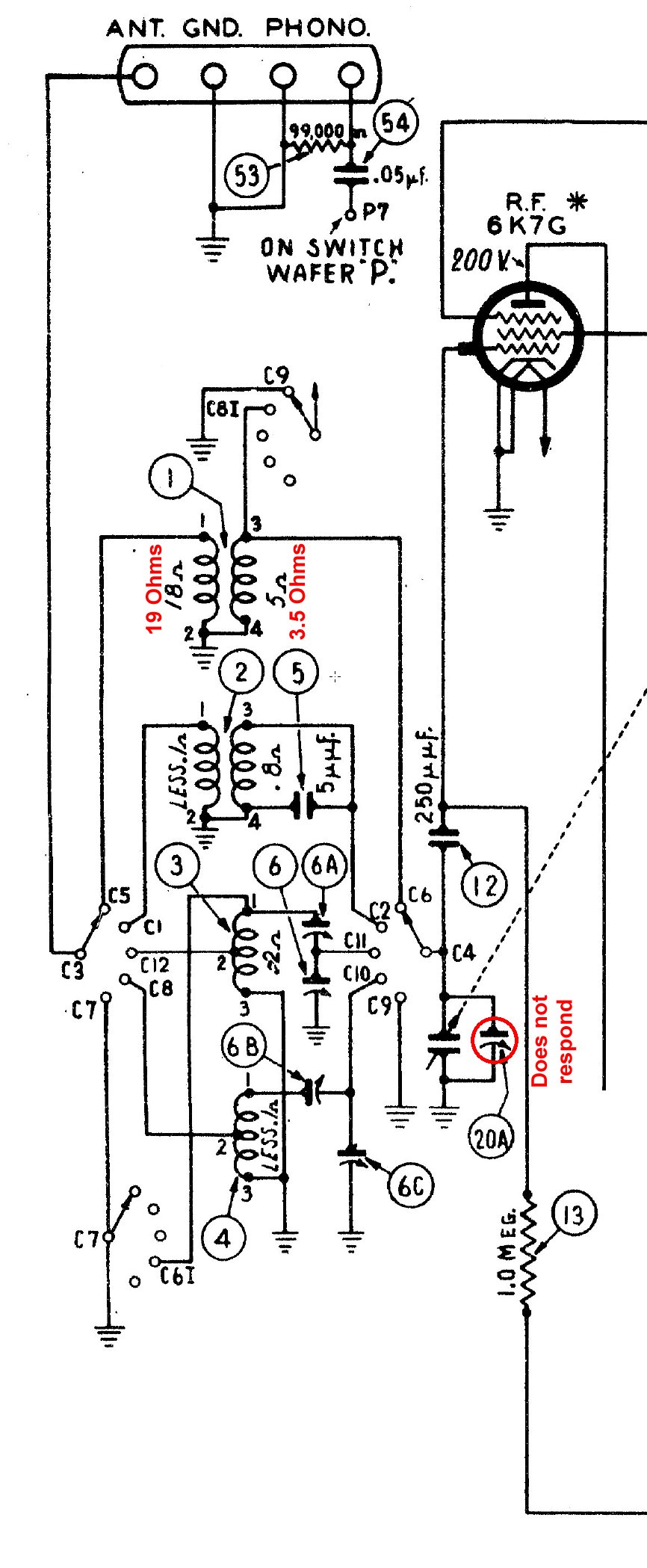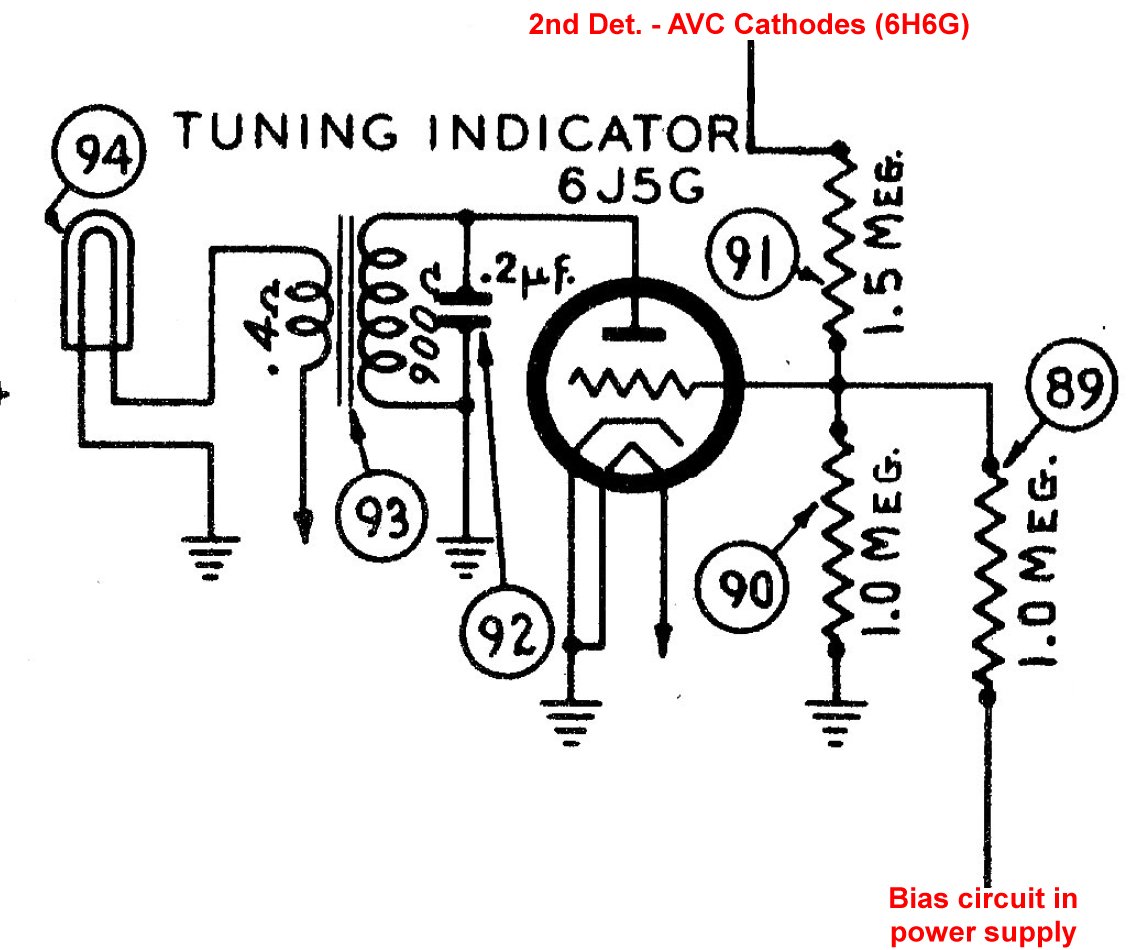Philco Tropic 39-770EZ Questions
Posts: 13,776
Threads: 580
Joined: Sep 2005
City: Ferdinand
State, Province, Country: Indiana
As you may or may not recall, I first began to work on this radio back in January 2015. Here is the thread.
When I wrapped up that thread on February 11 of the same year, I was wondering out loud whether an RF coil from a 39-45 would be a better replacement in this 770 than whatever was in it (it certainly was not the original coil). So, since then, I acquired a 39-45 parts chassis and transplanted its AM-police band RF coil in place of coil (8) in the 770.
Once I did that, AM reception showed a definite improvement.
However, when attempting an alignment, I found that I had another problem. Trimmer condenser (20A), the AM band antenna trimmer which is mounted across the antenna tuning condenser section, had zero effect on alignment.
Forgot to mention: I measured the AM antenna coil, thinking that might be the problem. You can see the measurements in red, in the partial schematic below. I expected the secondary to be open, as that is how the radio is acting - it is not. And this appears to be the original coil; it does not appear to have ever been out of the radio.
Background:
The mica sheet that was originally inside trimmer (20A) was missing, and so I did what I have done for many years when faced with that problem - I replaced the missing mica with a piece of clear plastic cut from one of those "blister pack" packages.
Mica capacitor (12), 250 pF, was bad, and was replaced.
Resistor (13), 1 meg., was also replaced.
You can see the full schematic here:
https://www.philcoradio.com/images/39-770.jpg
and the entire service info here:
https://philcoradio.com/library/download...20Book.pdf
Below is a partial schematic showing the set's front end. Now, while you guys mull that over, I have another question on this same radio - but a very different circuit - which I will ask next.

--
Ron Ramirez
Ferdinand IN
Posts: 13,776
Threads: 580
Joined: Sep 2005
City: Ferdinand
State, Province, Country: Indiana
Question #2:
This radio has what Philco called a "Fotometer Visual Tuning Indicator." Here is a description of how it is supposed to work, from a 1939 Philco booklet which includes listings of their Philco-Tropic models:
Quote:Fotometer Tuning Indicator - Improved visual tuning. The brilliance of the light decreases as you more accurately tune your station. Effective, simple, quick. No looking for an indistinct line (Models 750 and 770).
Only, in my set, the brilliance of the light increases as a station is tuned in, rather than decreases
Is this a problem, or a mistake made by Philco in their description?
Have a look at the partial schematic below. You can get more detail by looking at the full schematic (link above), but this should also be helpful.

--
Ron Ramirez
Ferdinand IN
Posts: 16,533
Threads: 573
Joined: Oct 2011
City: Jackson
State, Province, Country: NJ
Ron
For the trimmer cap, mica Dk (or Er), the dielectric constant, is twice the one of plexiglas. Which might affect the resulting capacitance range. Also I am not sure, but many plastics are somewhat hygroscopic and in absorbing water they change their Er and so the capacitance could drift. Also it can exhibit temperature drift.
As for the fotometr, I think it should go darker as the radio tunes in, as it is much easier to tell the darkest from less dark, then the brightest from less bright, as at some point the eye will get saturated and will not discern the changes of brightness well.
As for the principle, I am not sure, but could it employ saturation of the transformer or is it a saturable reactor? When the AVC signal goes down, it lessens the current via the 6J5G tube, which de-saturate the core, increases the inductance and dims the lightbulb which it is in series with.
If the AVC level goes up, it increases the tube curremty, saturate the reactor and so lessens the inductance and the bulb gets brighter.
People who do not drink, do not smoke, do not eat red meat will one day feel really stupid lying there and dying from nothing.
Posts: 16,533
Threads: 573
Joined: Oct 2011
City: Jackson
State, Province, Country: NJ
Did the search.
Colorama GE tuning indicator uses a similar principle, AVC and saturable reactor.
http://vrps.org/documents/ColoramaTuning.html
People who do not drink, do not smoke, do not eat red meat will one day feel really stupid lying there and dying from nothing.
Posts: 13,776
Threads: 580
Joined: Sep 2005
City: Ferdinand
State, Province, Country: Indiana
Ok. I will change the plastic insulator for mica, but I am very skeptical as to whether that alone will restore its adjustability. We shall see.
Oh, BTW - the plastic in there now is not Plexiglas, it is a very thin yet semi-stiff plastic such as used in various products you can buy at stores. You know, very thin, but allows you to see the product inside.
As for question #2, I guess I really should measure voltages at the 6H6G 2nd det-AVC tube cathodes, and at the "B-C" voltage divider where the circuit is also connected, find out what is going on, and report back later.
--
Ron Ramirez
Ferdinand IN
Posts: 883
Threads: 51
Joined: Feb 2013
City: Shenandoah,
State, Province, Country: Pennsylvania
Hi Ron, since I don’t profess to be an engineer, I will give my theory as to how your tuning indicator works so here goes. Since the plate circuit of the 6J5 tuning indicator tube goes to ground through the secondary of transformer #93 instead of back to some B+ supply, that puts the tube in parallel with the secondary. As the station gets stronger when tuning, the grid goes more positive or less negative from the cathode of the 6H6 AVC tube, thus making the tube more of a load across the secondary. This will reflect back to the primary as a lower impedance in series with the indicator bulb #94. This in turn would allow more current through the bulb giving a brighter response to an increasing signal strength, exactly what you are experiencing. Others may disagree with my theory.
Ron
Bendix 0626. RCA T64 Philco 20B
Philco 41-250. Philco49-500
GE 201. Philco 39-25
Motorola 61X13. Philco 46-42 Crosley 52TQ
Philco 37-116. Philco 70
AK 35 Philco 46-350
Philco 620B. Zenith Transoceanic B-600
Philco 60B. Majestic 50
Philco 52-944. AK 84
Posts: 145
Threads: 29
Joined: Dec 2016
City: portland, OR
did philco [or anybody else] make any other radios with a tuning indicator light?
i did find a clever alternative to the tuning indicator light described on the phorum.
https://philcoradio.com/phorum/showthrea...led+tuning
and a nice description of the shadow meter in the library. but no mention of the indicator light.
https://www.philcorepairbench.com/meter-...ndicators/
does anyone know what the name "tropic" refers to??
(This post was last modified: 11-07-2022, 05:55 PM by fenbach.)
Posts: 145
Threads: 29
Joined: Dec 2016
City: portland, OR
i see on the schematic that the plate of the one 6J5G tube for the indicator light is grounded thru a transformer. could that be right? the plates of the other 6J5G tubes are at 50-60V DC.
i'm still wondering, by the way, did philco [or anybody else] made another radio with a similar tuning indicator light bulb.
Users browsing this thread: 1 Guest(s)
|
|
Recent Posts
|
|
Philco newbie with P-1891-WA console questions
|
| Well, I've been stumped at trying to get the first of 11 electrolytic capacitors. I got a schematic and have a list of t...Jeffcon — 07:54 PM |
|
Model 80 Antenna Issue?
|
| Thanks Gary and Rod.
I also found an article in the Philco Repair Bench under Service Hints and Tips, about installi...Hamilton — 12:32 PM |
|
Model 80 Antenna Issue?
|
| Hello Hamilton, here is a little information found in our Philco Radio Library at the bottom of the Home page. Hope it ...GarySP — 11:28 AM |
|
Model 80 Antenna Issue?
|
| I did as you suggested and touching the middle of the volume control did nothing so the coil has to be rewound. Any idea...Hamilton — 10:19 AM |
|
1949 Motorola 5A9M
|
| This would be the second portable in the "other radios" forum where I have a similar one in my collection. I h...Arran — 12:41 AM |
|
Looking for any info: 1977 Ford-Philco Console Hi-Fi Turntable and Radio
|
| Hi PittsburgTost.
The record changer looks like a Garrard or BSR (Likely Garrard). The spindles just pull out and pu...MrFixr55 — 11:57 PM |
|
Looking for any info: 1977 Ford-Philco Console Hi-Fi Turntable and Radio
|
| Hello PittsburghToast ,
Welcome aboard and it looks like gary may have something for you !
now if I dig through my se...radiorich — 11:35 PM |
|
Model 80 Antenna Issue?
|
| You are kind of on the right path. You can touch the grid cap of the Detector/Oscillator 36 tube. I'm expecting a respon...RodB — 08:48 PM |
|
Looking for any info: 1977 Ford-Philco Console Hi-Fi Turntable and Radio
|
| Welcome to the Phorum, PittsburghToast! I found an old thread that my interest you regarding the quality and worth of P...GarySP — 08:48 PM |
|
Looking for any info: 1977 Ford-Philco Console Hi-Fi Turntable and Radio
|
| Welcome to the Phorum!
:wave:
We do not have anything on that unit in our digital library. There is a Sam's Photof...klondike98 — 08:47 PM |
|
Who's Online
|
There are currently 1062 online users. [Complete List]
» 4 Member(s) | 1058 Guest(s)
|
|
|

|
 
|




![[-] [-]](https://philcoradio.com/phorum/images/bootbb/collapse.png)


